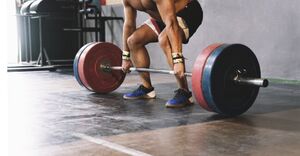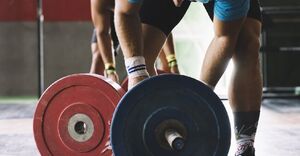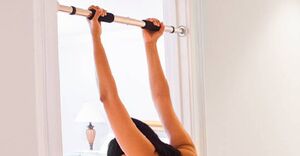
Essential Olympic Barbells Guide: Must-Have Picks for 2024
Looking to take your strength training to the next level?
Olympic barbells are a must-have piece of equipment for any serious lifter.
In this ultimate guide, we’ll cover everything you need to know about Olympic barbells, including their standard dimensions, different types, and the benefits of using them.
We’ll also discuss the key features to look for when choosing an Olympic barbell and provide tips on how to select the right one for your fitness goals.
Plus, we’ll highlight the best exercises you can do with an Olympic barbell to maximize your gains. Let’s dive in!
What Is an Olympic Barbell?
An Olympic barbell is a type of barbell specifically designed for Olympic weightlifting and strength training exercises. It is a fundamental piece of exercise equipment used in weightlifting and various strength training programs.
The Olympic barbell’s long and sturdy design allows for a wide range of movements and exercises, making it versatile for different types of lifts such as squats, deadlifts, and presses.
The evenly distributed weight along the bar helps in developing balanced muscle strength and power. The rotating sleeves of the Olympic barbell allow for smoother and more efficient lifts, reducing the risk of injury during training sessions.
The use of an Olympic barbell not only enhances performance but also promotes muscle building and overall strength gains.
What Are the Standard Dimensions of an Olympic Barbell?
The standard dimensions of an Olympic barbell include a bar diameter of 28mm for men’s bars and 25mm for women’s bars. The length of the bar is typically 7.2 feet (2.2 meters) with rotating sleeves to accommodate Olympic-sized weight plates.
Olympic barbells are designed to meet specific standards to ensure consistency across competitions and training facilities. These bars are crafted with precision, providing a reliable and durable piece of equipment for weightlifting enthusiasts.
The weight plate compatibility of Olympic barbells is crucial, with the sleeves allowing easy and secure attachment of standardized plates. When selecting an Olympic barbell, it is essential to consider the quality standards, such as the tensile strength of the steel used in construction, the knurling pattern for grip, and the overall balance and feel of the bar during lifts.
What Are the Different Types of Olympic Barbells?
There are different types of Olympic barbells based on their construction, including those with bearings for smooth sleeve rotation and reduced friction, barbells with bushings for durability and stability, and specialized collars for secure plate attachment.
Barbells with bearings are often preferred by athletes and weightlifters for their ability to provide a consistent spin during lifts, allowing for smoother transitions between movements. On the other hand, barbells with bushings are known for their sturdiness and ability to withstand heavy loads without compromising performance.
The collars on Olympic barbells play a crucial role in keeping the plates securely in place, preventing any slippage or shifting during intense workouts. Understanding the differences in these barbell features can help individuals choose the right equipment to enhance their training regimen.
What Are the Benefits of Using an Olympic Barbell?
Using an Olympic barbell offers numerous benefits for weightlifting and strength training enthusiasts. These benefits include improved performance, enhanced strength gains, and increased versatility in exercise routines.
Incorporating Olympic barbells into workout routines plays a key role in injury prevention by promoting proper form and technique. The design of Olympic barbells, with their standardized length and weight, helps individuals execute movements with precision, reducing the risk of strain or overuse injuries. By focusing on form and technique, athletes can maximize their strength gains and minimize the likelihood of setbacks, allowing them to progress steadily towards their fitness goals.
Versatility for Different Exercises
The versatility of Olympic barbells allows for a wide range of exercises, including powerlifting movements, CrossFit workouts, and variations of Olympic lifts such as the clean and jerk and snatch.
These barbells are essential tools in powerlifting routines, enabling athletes to perform squats, deadlifts, and bench presses with optimal form and resistance. In CrossFit training, Olympic barbells are utilized for dynamic movements like snatches and thrusters, promoting strength, speed, and endurance. The unique design of Olympic barbells supports the precision required in Olympic weightlifting techniques, enhancing explosive power in lifts like clean and jerks and snatches. The adaptability of these barbells across different exercise disciplines makes them a cornerstone in any well-rounded training regimen.
Increased Strength and Muscle Development
One of the key benefits of using Olympic barbells is the potential for increased strength and muscle development. By incorporating proper technique and consistent training sessions, individuals can achieve significant muscle gains and strength improvements.
This form of weight training with Olympic barbells is highly effective in engaging multiple muscle groups simultaneously, leading to improved overall strength and coordination. The dynamic nature of movements such as the clean and jerk or snatch not only build muscle but also enhance power and explosiveness. The adaptability of Olympic barbell exercises allows for progressive overload, a fundamental principle in strength training for continuous muscle growth and development. When combined with a balanced nutrition plan, athletes and fitness enthusiasts can maximize their training efficiency and yield optimal results in both muscle building and strength gains.
Improved Grip Strength
Using Olympic barbells can lead to improved grip strength due to the knurling on the bar surface that enhances grip security and comfort during lifts. This improved grip strength translates to better performance in various exercises.
The knurling pattern on Olympic barbells plays a crucial role in providing traction for the hands, preventing slipping during movements. The textured surface created by the knurling helps distribute the weight evenly and allows for a firmer grasp, reducing the risk of the barbell slipping out of your hands. This added stability and control not only enhance your lifting technique but also promote safer and more effective workouts.
The strategic placement of the knurling on the barbell ensures that the hands can maintain a secure grip throughout the entirety of each lift, giving you the confidence to push your limits and achieve greater results.
Better Balance and Coordination
The use of Olympic barbells promotes better balance and coordination during lifts, requiring individuals to focus on stability and technique. This improved balance and coordination are essential for performing exercises effectively and reducing the risk of injury.
Through the engagement of various muscle groups to maintain equilibrium while lifting, individuals can develop a stronger core and overall stability. By honing in on proper form and utilizing the barbell’s weight strategically, lifters can enhance their proprioception and spatial awareness. These factors not only improve balance and coordination but also help prevent muscle imbalances and potential joint strain. With consistent practice and attention to detail, weightlifters can master the art of controlled movement, benefiting both their performance and long-term physical health.
What Features Should You Look for in an Olympic Barbell?
When selecting an Olympic barbell, it is essential to consider key features that contribute to its quality, performance, and durability. These features play a crucial role in determining the barbell’s overall effectiveness and longevity.
Quality construction in Olympic barbells ensures that the barbell can withstand heavy use without bending or warping, providing a stable platform for various exercises. Performance-enhancing elements, such as the knurling pattern and the bar’s spin, contribute to a secure grip and smooth rotation during lifts, enhancing the user’s overall experience. Long-lasting durability means that the barbell will remain reliable over time, allowing athletes to focus on their training without worrying about equipment failure.
Weight Capacity and Durability
Weight capacity and durability are vital considerations when evaluating an Olympic barbell. Factors such as tensile strength, rust resistance, and overall build quality determine the barbell’s ability to withstand heavy loads and long-term use.
Tensile strength is crucial as it measures the barbell’s resistance to bending or breaking under stress, which is essential for heavy lifting.
Rust resistance plays a key role in preserving the barbell’s appearance and structural integrity over time, ensuring longevity.
The quality of materials used, such as alloy steel or stainless steel, greatly impacts the barbell’s performance and durability.
By investing in a barbell with high weight capacity and superior build, athletes can enhance their training experience and achieve optimal results.
Knurling and Grip
The knurling pattern and grip comfort of an Olympic barbell are crucial features that impact the user’s experience and lifting performance. The right knurling depth and pattern provide a secure grip and enhance overall comfort during lifts.
A well-designed knurling on the barbell not only prevents slippage but also allows the lifter to maintain a firm hold, reducing the risk of injuries. The texture of the knurling plays a key role in enhancing tactile feedback, aiding in proper hand placement and alignment for different exercises. By promoting a secure and comfortable grip, knurling contributes significantly to the overall effectiveness and safety of weightlifting routines, making it an essential aspect of any serious lifter’s equipment selection.
Sleeve Rotation
Sleeve rotation in Olympic barbells is facilitated by quality bearings or bushings, allowing smooth and controlled plate movement during lifts. This feature ensures that the weight plates rotate efficiently, reducing stress on the lifter’s wrists and improving overall lifting experience.
The collars at the end of the barbell play a crucial role in keeping the weight plates securely in place, preventing any sliding or shifting during lifts. This stability provided by the collars, in conjunction with the smooth sleeve rotation, allows lifters to focus on their technique and form without distractions.
The combination of bearings, bushings, and collars ensures a seamless lifting experience, enabling athletes to push themselves to their limits while minimizing the risk of wrist injuries or strains.
Bar Flexibility
Bar flexibility, often referred to as ‘whip’, is a crucial feature in Olympic barbells that affects the bar’s ability to store and release energy during dynamic lifts. The presence of a center knurl on the barbell can enhance grip and stability during squats and other exercises.
This flexibility, or ‘whip’, is determined by the material and design of the barbell, influencing how much it bends under load. When a lifter performs explosive movements like snatches or clean and jerks, the bar’s whip allows it to briefly deform and then spring back, aiding in the transfer of power from the lifter to the weights. A balance between flexibility and rigidity is crucial; too much whip can result in loss of control, while too little can limit the energy transfer efficiency.”
How to Choose the Right Olympic Barbell for You?
Selecting the right Olympic barbell involves considering your fitness goals, budget constraints, and personal preferences. Beginners should focus on choosing a barbell that aligns with their training needs and skill level.
- For those aiming to build strength, a barbell with a higher weight capacity and durable construction would be essential.
- Advanced lifters might prioritize features like knurling for a better grip and rotating sleeves for smoother lifts.
It’s also crucial to evaluate the bar’s material, as stainless steel bars offer superior durability compared to chrome-plated ones. Budget-friendly options can still provide quality if you prioritize basic functionalities over fancy features. Remember, the right Olympic barbell can significantly impact your training outcomes, so make your choice wisely.
Determine Your Fitness Goals
Understanding your fitness goals is crucial in selecting the right Olympic barbell that aligns with your training objectives. Whether you aim for muscle building, strength gains, or improved performance, choosing a barbell that supports your fitness goals enhances training efficiency.
Defining your specific training objectives plays a vital role in determining the type of Olympic barbell that would best suit your needs. For instance, if you prioritize powerlifting, a barbell designed for high-intensity lifts with a higher weight capacity would be ideal. On the other hand, those focusing on Olympic lifting might benefit from a barbell that provides greater flexibility and spin for movements like snatches and clean and jerks. By aligning your barbell choice with your training objectives, you not only optimize your workouts but also reduce the risk of injury and maximize performance gains.
Consider Your Budget
Consideration of your budget is essential when purchasing an Olympic barbell. While there are budget-friendly options available, investing in high-end models may offer additional features and durability for long-term use.
Budget-friendly Olympic barbells can be a great choice for beginners or those on a tight budget. These bars often sacrifice some premium features found in high-end models but can still provide a decent performance.
On the other hand, premium barbell models are crafted with higher quality materials and precision engineering, making them more suitable for serious athletes or individuals looking for top-notch performance. The key is to strike a balance between cost-effective choices and investing in a barbell that will withstand heavy use and provide consistent performance over time.
Read Reviews and Compare Brands
Before making a purchase decision, it is advisable to read reviews and compare different Olympic barbell brands. Each brand offers unique features, quality standards, and product variations that cater to diverse user preferences and training requirements.
Researching various Olympic barbell brands can provide valuable insights into the differences in materials, knurling patterns, weight capacity, and overall durability. By understanding these distinctions, consumers can make an informed choice based on their specific needs.
User feedback and reviews play a crucial role in assessing the reliability and performance of a particular brand. Taking the time to explore different options will not only help buyers find a high-quality Olympic barbell but also ensure that it aligns with their fitness goals and training regimen.
What Are the Best Exercises to Do with an Olympic Barbell?
Olympic barbells are versatile tools for performing a wide range of exercises that target different muscle groups and movement patterns. Some of the best exercises to do with an Olympic barbell include squats, deadlifts, clean and jerks, and other compound movements.
These key movements not only help in building strength but also improve muscle engagement and overall athleticism. Incorporating squats into your routine can enhance lower body strength, while deadlifts work multiple muscles simultaneously, supporting a strong back and core. Clean and jerks are fantastic for explosive power and full-body coordination, making them a great addition to any workout regimen. By focusing on these compound exercises with Olympic barbells, individuals can achieve well-rounded development and functional fitness.
Squats
Squats are fundamental exercises in weightlifting and functional fitness, and using an Olympic barbell can enhance the effectiveness of squat variations. The barbell adds resistance and stability, engaging multiple muscle groups during squat movements.
The Olympic barbell’s design allows for incremental loading, enabling individuals to progressively increase the weight lifted as strength improves. This progressive overload is crucial for muscle growth and strength development in squats. The barbell’s placement on the upper back promotes proper posture, core activation, and overall stability during the squat movement. By incorporating Olympic barbells into squat workouts, individuals can target their quadriceps, hamstrings, glutes, and core muscles more effectively, resulting in improved functional strength and performance.
Deadlifts
Deadlifts are compound exercises that target the posterior chain and core muscles, and utilizing an Olympic barbell allows for optimal technique practice and progress tracking. The barbell’s design supports proper form and weight distribution during deadlift movements.
This emphasis on technique when incorporating Olympic barbells into deadlift workouts not only helps in preventing injuries but also ensures maximum muscle engagement. By maintaining proper alignment and form, individuals can effectively activate muscles across the lower back, glutes, hamstrings, and even the upper body. Using Olympic barbells for deadlifts enables individuals to monitor their progress more efficiently, as they can easily track and adjust the weight they lift, allowing for gradual strength gains over time.
Bench Press
The bench press is a classic chest and upper body exercise that can be optimized with an Olympic barbell. Proper bench press technique with the barbell promotes muscle development, strength gains, and injury prevention through controlled movements and stability.
Utilizing an Olympic barbell for bench press exercises allows for a greater range of motion compared to other equipment, engaging more muscle fibers for efficient strength-building. Variations like incline or decline bench presses with the barbell target different parts of the chest and shoulders, contributing to a well-rounded upper body workout. It is crucial to maintain proper form, such as keeping the shoulders retracted and elbows at the correct angle, to ensure maximum muscle activation and minimize the risk of strain or injury during the exercise.
Overhead Press
The overhead press, including the shoulder press, is a key exercise for developing shoulder strength and stability. Using an Olympic barbell for overhead presses enhances technique precision and supports athletic abilities by targeting shoulder muscles effectively.
Incorporating overhead press movements with Olympic barbells into training regimens can lead to significant improvements in overall shoulder stability and strength. These exercises not only help in enhancing athletic performance but also contribute to refining the specific technique required for overhead pressing movements. The controlled nature of using an Olympic barbell adds an extra dimension to the workout, requiring the engagement of stabilizing muscles, thereby promoting better form and reducing the risk of injury during training sessions.
Rows
Rowing exercises with an Olympic barbell are effective for targeting back muscles and improving posture and strength. Incorporating rows into workout routines with the barbell allows for progressive overload and efficient progress tracking in back muscle development.
- Variations such as bent-over rows
- T-bar rows
- Pendlay rows
can be performed using an Olympic barbell, providing a versatile workout for different parts of the back. By engaging multiple muscles in the back, including the latissimus dorsi, rhomboids, and trapezius, rowing exercises with an Olympic barbell can enhance overall strength and stability.
Regularly performing these exercises not only helps in building a stronger back but also assists in correcting imbalances and asymmetries, leading to better posture and reduced risk of injuries.




No Comments